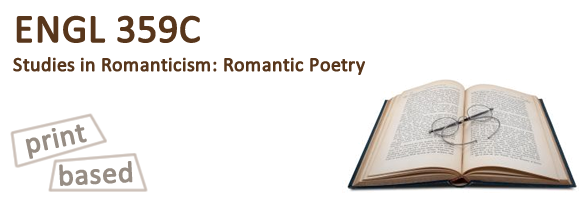
Mode of Delivery
This is a print-based, correspondence course.
Course Outline
- Five assignments
- Final examination
Course Description and Prerequisites
English 359C: Romantic Poetry highlights the works of the six major English Romantic poets, Blake, Wordsworth, Coleridge, Byron, Shelley, and Keats. You will have the opportunity of revisiting favourite short poems, sonnets, and odes by these beloved poets. In addition, the course will devote much of its emphasis to the major poems:
- Wordsworth’s Prelude
- Coleridge’s Rime of the Ancient Mariner
- Blake’s Milton: a Poem in 2 Books
- Keats’s Hyperion and The Fall of Hyperion
- Shelley’s Prometheus Unbound
- Byron’s Don Juan
Prerequisites are six credits of first-year English, or Arts One, or Foundations, and third-year standing.
Course Overview
- Lesson 1, “The First Generation of English Romantic Poets,” surveys relationships among Blake, Wordsworth, and Coleridge, how the term “Romantic Period” was invented, and how these three poets relate to their predecessors, especially in the seventeenth and eighteenth centuries. The purpose of Lesson 1 and its study questions is to direct you to essential features of literary history and prepare you for the traditional and innovative qualities to look for when reading the works of our first three poets.
- Lesson 2, “Wordsworth and Coleridge,” calls to your attention one of the most significant of all literary friendships and has a fourfold objective: 1) to highlight the range of their verse forms by presenting representative examples of the ballad, shorter rhymed lyrics, the sonnet, the ode, and blank verse; 2) to show the creative influences of Wordsworth and Coleridge on each other; 3) to invite you to study the relationship of shorter to longer works, by which means The Prelude will be featured; and 4) to help you become acquainted with the nature of symbolic poetic form as a vehicle for the expression of what these poets mean by the imagination.
- Lesson 3, “Blake and Coleridge,” presentsa guide to Blake’s personal symbolism, which is then illustrated by selected lyrics and narrative works, culminating in the prophetical poem Milton: a Poem in 2 Books. The theme of alienation, as it is treated by Blake, invites comparison with Coleridge’s haunting expression of that theme in The Rime of the Ancient Mariner. Lesson 3 also studies the relationship of Blake the painter to Blake the poet, notes the particular character of his personal symbolism, and compares the themes of two major poems by these poets.
- With Lesson 4, “The Second Generation of English Romantic Poets,” we begin the second half of the course. This lesson explores the relationships of Byron, Shelley, and Keats to one another and to their immediate Romantic predecessors. We shall also consider how changes in the political and historical climate may be reflected in the new thematic emphases to be found in the works of these poets.
- Lesson 5, “Keats,” examines the ways in which the poet’s theory of soul-making can be found in his narrative poems, sonnets, and odes. We shall also look for thematic and stylistic evidence that might help explain how Keats’s poetical growth and development could have occurred over such an incredibly short time.
- In Lesson 6, “Shelley,” we encounter another poet who, like Blake, employed personal symbolism in his major works. This lesson explores that symbolism in a variety of works from Alastor to Adonais and highlights its musical manifestation in Shelley’s greatest poem, Prometheus Unbound.
- Lesson 7, “Byron,” presents us with the conundrum of a poet who has given us the gloomy, aloof Byronic Hero and, at the same time, has written some of the most hilarious and urbane satire in the language. The purpose of the lesson is two-fold: 1) to study the Byronic Hero in such works as Manfred and Childe Harold’s Pilgrimage, and 2) to account for the brilliant satirist and lover of Pope and Milton in such works as The Vision of Judgment and Don Juan.
- The course concludes with Lesson 8, “From the Romantics to the Moderns,”in which we sum up the achievements and influence of the Romantic poets. We shall look at their impact on various Victorian and Modern poets and consider whether or not we are still living in a Romantic period. English 359C takes the form of eight lessons.
Course Goals
When you have completed English 359C, you should:
- be familiar with the major poetic works of the major English Romantic poets;
- have acquired an appreciation of the invigorating variety of verse forms they employ, both in short and long poems, as well as a sense of the relationship between the themes and ideas of the shorter and longerworks; and
- be encouraged to come to grips with Romantic symbols and symbol-making, perhaps the most outstanding contribution of these writers to the history of literature.
Course Work
The five essay assignments for English 359C occur at the ends of lessons on specific Romantic poets and should be roughly 1,500 to 2,000 words in length. You may choose the subject for an essay from the list of topics provided, or you may devise your own in consultation with your instructor. The suggested topics invite you to write critical essays rather than research papers and thus require you to read and understand poems with thoughtfulness and familiarity.
Evaluation
Your course grade in English 359C consists of the following:
- Essays (5 @ 15 marks each) – 75%
- Final Exam – 25%
Required Text – ENGL359C Textbook Order Form
ENGL 359C Custom Course Materials. Reprint of Heath, William, ed. Major British Poets of the Romantic Period. New York: MacMillan, 1973.
ENGL 359C Learner Package (includes course manual)
